
Tales Across Time is a small, somewhat experimental RPG which isn’t afraid to take a few risks with its storytelling and combat system. Though not completely devoid of clichés, this RPG forsakes presenting players with a grand globetrotting adventure in order to tell three short stories about characters and events in a single location over the course of several hundred years.
This is a short, focused game, coming in at about four hours in length, and, for the most part, its abrupt, direct nature works in its favor. Each of the three ‘stories’ is only about an hour in length, so don’t expect anything in the way of elaborate puzzles, deep lore, secret sidequests, or lengthy dungeon delving. Gone too are experience points, equipment, complicated stats, and random encounters; the only upgrades to find are a few crystals which boost HP and AP (which is used for skills) and every fight is by design. Instead, each scenario revolves around the exploits of and interactions between two characters, just about all of whom get a surprising amount of characterization and development over the span of their hour-long stories. Several supporting characters also exist, though they are significantly less developed and largely serve to move the plot along or to flesh out each story’s main duo. There may not be much in the way of worldbuilding, and I do think Tales Across Time could use more in the way of flavor text tied to environmental interactions, but the transformation of the region from desert ruins to a thriving village to a sci-fi fortress in the middle of a forest does a great job of indicating both the passage of time and the general nature of the setting without a need for exposition.
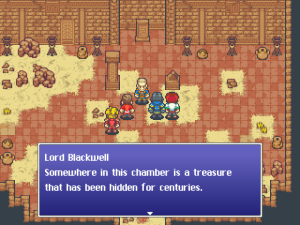 The writing itself is mostly well-done, but it is not without a few issues. On the plus side of things, the tightly focused nature of the narrative results in just about all of the dialogue serving to expand upon the backgrounds, motivations, personalities, and relationships of the main characters or to meaningfully advance the story along and most of the character interactions feel natural. The divided nature of the narrative also adds more of an element of suspense to the plot than would be found in a game with a more stable cast; it can be difficult to guess just how or when each story will end and, since the characters are not directly connected, the success and survival of each character by the end of their own story is not guaranteed. As enemy encounters are not random and do not respawn, a good number of them serve to further develop the characters. For example, the second story, which is my favorite of the three, centers on Claire and James, a soon-to-be-married couple, and near the start of their adventure James is attacked by a monster and knocked unconscious. In this situation, players take control of Claire and must not only defeat the monster, but must do so while making sure that both James and Claire remain alive by blocking attacks aimed at James and through using a ‘Distraction’ skill, unique to the fight, which temporarily diverts the monster’s attention towards attacking Claire instead of James. Though not every single encounter ties into the narrative, enough of them do that they are nearly as important to the storytelling as the actual dialogue.
The writing itself is mostly well-done, but it is not without a few issues. On the plus side of things, the tightly focused nature of the narrative results in just about all of the dialogue serving to expand upon the backgrounds, motivations, personalities, and relationships of the main characters or to meaningfully advance the story along and most of the character interactions feel natural. The divided nature of the narrative also adds more of an element of suspense to the plot than would be found in a game with a more stable cast; it can be difficult to guess just how or when each story will end and, since the characters are not directly connected, the success and survival of each character by the end of their own story is not guaranteed. As enemy encounters are not random and do not respawn, a good number of them serve to further develop the characters. For example, the second story, which is my favorite of the three, centers on Claire and James, a soon-to-be-married couple, and near the start of their adventure James is attacked by a monster and knocked unconscious. In this situation, players take control of Claire and must not only defeat the monster, but must do so while making sure that both James and Claire remain alive by blocking attacks aimed at James and through using a ‘Distraction’ skill, unique to the fight, which temporarily diverts the monster’s attention towards attacking Claire instead of James. Though not every single encounter ties into the narrative, enough of them do that they are nearly as important to the storytelling as the actual dialogue.
So, just where do the issues with the writing come in? The most obvious issue is that Tales Across Time suffers from an excess of ellipses. I don’t at all mind if a game occasionally uses some ellipses to indicate a pause in dialogue, but here it seems like at least one set of ellipses is used in nearly every dialogue box and seeing two or even three such sets in a single line of dialogue is not too uncommon. The overreliance on ellipses is especially noticeable because the speed at which the text is written usually is decreased while these sets of dots are being typed out and on a few occasions I ended up accidentally skipping a line of dialogue while trying to make the text move faster; keeping variable text speeds to indicate the flow of speech while significantly cutting back on ellipses would have greatly improved the writing.
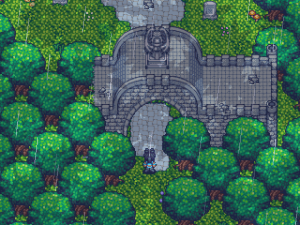 Another issue, though a lesser one, comes in the form of John, the non-playable main character of the third story. There is nothing outright wrong with John, but he doesn’t really get a moment to shine and you never learn much about him compared to James and Monica, the non-playable main character of the first story. The general lack of importance and characterization which John possesses is somewhat alleviated by the fact that the third story focused much more heavily upon developing Caitlyn as a character and her relationship with the antagonist, but this leads to the final issue with the writing. Other than the location, the one common thread shared by these three tales is the cartoonishly evil antagonist. Though the antagonist’s characterization is clearly deliberate and I enjoy a good comedic-yet-dangerous villain (the Joker and Kefka are certainly both amongst my favorite villains), in this particular case they come off as a bit too one-dimensional without much in the way of potential hidden depth despite their presence in all three plots making them a strong contender for the character with the most screen time.
Another issue, though a lesser one, comes in the form of John, the non-playable main character of the third story. There is nothing outright wrong with John, but he doesn’t really get a moment to shine and you never learn much about him compared to James and Monica, the non-playable main character of the first story. The general lack of importance and characterization which John possesses is somewhat alleviated by the fact that the third story focused much more heavily upon developing Caitlyn as a character and her relationship with the antagonist, but this leads to the final issue with the writing. Other than the location, the one common thread shared by these three tales is the cartoonishly evil antagonist. Though the antagonist’s characterization is clearly deliberate and I enjoy a good comedic-yet-dangerous villain (the Joker and Kefka are certainly both amongst my favorite villains), in this particular case they come off as a bit too one-dimensional without much in the way of potential hidden depth despite their presence in all three plots making them a strong contender for the character with the most screen time.
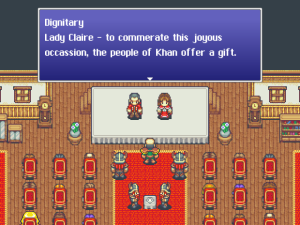 Combat is turn-based, but it’s far from traditional. HP and AP are the only stats in the game, both of which are low and can only be slightly raised by finding crystals, of which there are three in the first two parts and four in the final story. Every fight is a one-on-one encounter and you start each fight with full HP and half of your AP. While in a fight, the four main commands are Attack, Skill, Defend, and Heal and, unlike in many RPG’s, you’ll be using all of these frequently. ‘Attack’ actually consists of three different options: a weak attack which deals 25% less damage while generating 3 AP, a normal attack which generates 2 AP, and a strong attack which deals 25% more damage while only generating a single AP. The ‘Skill’ command grants access to four different skills, which differ between the characters and are generally offensive in nature; every skill uses up AP and most use somewhere between 4-6 AP per use so, even though many of the offensive skills are much stronger than a ‘strong’ attack, you usually want to avoid running too low on AP for those times when a defensive skill is needed. Defend cuts damage taken in half like in most RPG’s, but it also generates a point of AP to make it a much more viable option than usual. The final option, Heal, varies the most in terms of usefulness depending on the character you are controlling and the enemy you are fighting as it has a high cost of 5 AP and heals a flat 50% of your maximum HP; green crystals each provide a +5 boost to HP and there are also minor differences in the natural maximum amounts between the three playable protagonists so even a seemingly minor difference such as 20 maximum HP versus 30 maximum HP has a significant impact on the usefulness of Heal.
Combat is turn-based, but it’s far from traditional. HP and AP are the only stats in the game, both of which are low and can only be slightly raised by finding crystals, of which there are three in the first two parts and four in the final story. Every fight is a one-on-one encounter and you start each fight with full HP and half of your AP. While in a fight, the four main commands are Attack, Skill, Defend, and Heal and, unlike in many RPG’s, you’ll be using all of these frequently. ‘Attack’ actually consists of three different options: a weak attack which deals 25% less damage while generating 3 AP, a normal attack which generates 2 AP, and a strong attack which deals 25% more damage while only generating a single AP. The ‘Skill’ command grants access to four different skills, which differ between the characters and are generally offensive in nature; every skill uses up AP and most use somewhere between 4-6 AP per use so, even though many of the offensive skills are much stronger than a ‘strong’ attack, you usually want to avoid running too low on AP for those times when a defensive skill is needed. Defend cuts damage taken in half like in most RPG’s, but it also generates a point of AP to make it a much more viable option than usual. The final option, Heal, varies the most in terms of usefulness depending on the character you are controlling and the enemy you are fighting as it has a high cost of 5 AP and heals a flat 50% of your maximum HP; green crystals each provide a +5 boost to HP and there are also minor differences in the natural maximum amounts between the three playable protagonists so even a seemingly minor difference such as 20 maximum HP versus 30 maximum HP has a significant impact on the usefulness of Heal.
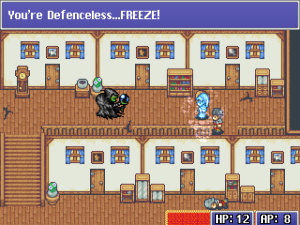 What makes the combat particularly great is not so much the system itself, but how the system is used and changed. Since fights are not random and there is little stat progression, nearly every encounter feels like a unique miniboss fight, though there are a very small handful of repeats. As the first protagonist, Flynn’s fights largely exist to familiarize players with the basic combat system and never become much more complicated than requiring the use of his stun skill if the opponent starts to charge up an attack. However, both Claire and Caitlyn encounter enemies which require players to learn their attack patterns, which use a variety of status ailments or buffs, or which require the use of a fight-specific ability, such as the ‘Distraction’ skill I mentioned in relation to one of Claire’s fights earlier. As every fight has a unique mechanic or gimmick, the risk associated with making a fatal mistake while learning the fight is reduced by the game automatically checkpointing players before each fight to minimize progress loss.
What makes the combat particularly great is not so much the system itself, but how the system is used and changed. Since fights are not random and there is little stat progression, nearly every encounter feels like a unique miniboss fight, though there are a very small handful of repeats. As the first protagonist, Flynn’s fights largely exist to familiarize players with the basic combat system and never become much more complicated than requiring the use of his stun skill if the opponent starts to charge up an attack. However, both Claire and Caitlyn encounter enemies which require players to learn their attack patterns, which use a variety of status ailments or buffs, or which require the use of a fight-specific ability, such as the ‘Distraction’ skill I mentioned in relation to one of Claire’s fights earlier. As every fight has a unique mechanic or gimmick, the risk associated with making a fatal mistake while learning the fight is reduced by the game automatically checkpointing players before each fight to minimize progress loss.
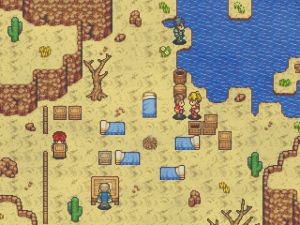 Additionally, Claire and Caitlyn each change up the combat system in their own ways. As a character who is not familiar with combat, Claire has the lowest health and does not actually have access to any skills so balancing AP and defending at the right times are very important in her encounters and nearly all of her fights include a unique gimmick or require her to significantly weaken an enemy and save up a large amount of AP so James can land a finishing blow. Meanwhile, Caitlyn can find Power Cells in chests, single-use consumables which can either be used to fully shield her from damage or to triple her attack power for a turn. Caitlyn’s skills are also remarkably varied and consist of a stackable attack boost, a high-cost attack, a weaker attack which can reduce the opponent’s accuracy, and, most importantly, the Brace skill, which serves as an interesting alternative to Defend as it only heals 25% of Caitlyn’s HP for 4 AP, but it also completely blocks damage for the turn. Some fights, especially near the end of the game, felt like they went on too long during my playthrough, but this was likely due to my own playstyle being an overly defensive one and the frequent tweaks made to the combat system between fights and between characters keep combat fun and interesting all the way through.
Additionally, Claire and Caitlyn each change up the combat system in their own ways. As a character who is not familiar with combat, Claire has the lowest health and does not actually have access to any skills so balancing AP and defending at the right times are very important in her encounters and nearly all of her fights include a unique gimmick or require her to significantly weaken an enemy and save up a large amount of AP so James can land a finishing blow. Meanwhile, Caitlyn can find Power Cells in chests, single-use consumables which can either be used to fully shield her from damage or to triple her attack power for a turn. Caitlyn’s skills are also remarkably varied and consist of a stackable attack boost, a high-cost attack, a weaker attack which can reduce the opponent’s accuracy, and, most importantly, the Brace skill, which serves as an interesting alternative to Defend as it only heals 25% of Caitlyn’s HP for 4 AP, but it also completely blocks damage for the turn. Some fights, especially near the end of the game, felt like they went on too long during my playthrough, but this was likely due to my own playstyle being an overly defensive one and the frequent tweaks made to the combat system between fights and between characters keep combat fun and interesting all the way through.
Tales Across Time cuts straight to the point in both its combat and its narrative by eschewing many of the tedious or pointless elements which bog down other RPG’s. Linearity and a lack of optional content are not always good traits, I even noted the lack of optional tasks as a downside to Epikos, but they work well with this game’s short story structure to keep up a tightly paced narrative. The writing could use some work in spots, but Tales Across Time gets it right in the most important areas and, with a very reasonable $2.99 price, this game has much to offer during its short stay.